-

《弯弯的月亮》教案
教学过程:一、导入:播放克莱德曼的钢琴曲《思乡曲》作为背景,结合图片,创设情境,谈话式导入新课。师:现在同学们听到的这首钢琴曲,旋律优美,略带忧伤,作者想表达什么呢?这首曲子名为《乡愁》,也被译作《思乡曲》。古今中外,思乡之情人皆有之,思乡之作举不胜举,很小的时候,大家都会吟诵“举头望明月,低头思故乡。”月亮仿佛成了思想的代名词,久别家乡的游子,仿佛能从月亮里看到家乡亲人的笑脸,看到自己童年的情景。月儿总是故乡明,无论身在何地,离开故乡的游子都会时刻挂念自己的家乡。今天的音乐课我们就来学唱一首带有思想情绪的歌曲《弯弯的月亮》。思考题:已知单线谱线上的音符唱“re”,你能推算出其他音符的唱名么?跟琴视唱声曲谱。这首短短的曲谱里蕴含着音乐家的思乡之情。老师这里也有一首小曲,一起来听听,请看大屏幕。【设计意图:传统的谈话式导入,借助音乐、画面、语言,创设情境。】二、歌曲教学:1、出示旋律图谱。2、学生在老师钢琴的引导下,用首调视唱曲谱,简单了解一个降号调的演唱,并用lu体会悠扬的思乡之情。3、教师设问:请同学们循环重复演唱这两句旋律,你们在唱的时候,还会听到老师不同的声音,我们来试试看。
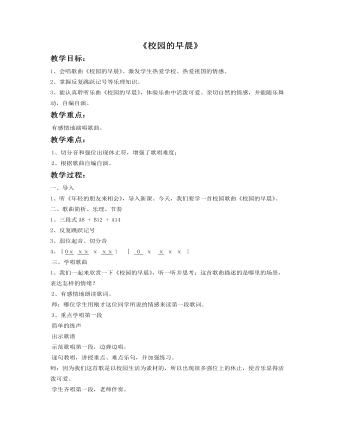
《校园的早晨》教案
教学过程:一、导入1、听《年轻的朋友来相会》,导入新课。今天,我们要学一首校园歌曲《校园的早晨》。二、歌曲简析、乐理、节奏1、三段式A8 + B12 + A142、反复跳跃记号3、弱位起音、切分音4、︱0ⅹ ⅹⅹ ⅹ ⅹⅹ∣ ︴ 0 ⅹ ⅹ ⅹ ⅹ ∣ 三、学唱歌曲1、我们一起来欣赏一下《校园的早晨》,听一听并思考:这首歌曲描述的是哪里的场景,表达怎样的情绪?2、有感情地朗读歌词。师:哪位学生用刚才这位同学所说的情感来读第一段歌词。 3、重点学唱第一段简单的练声出示歌谱示范歌唱第一段,边弹边唱。逐句教唱,讲授重点、难点乐句,并加强练习。师:因为我们这首歌是以校园生活为素材的,所以出现很多强位上的休止,使音乐显得活泼可爱。学生齐唱第一段,老师伴奏。 打节奏要清晰,打的声音不要太大。4、学唱第二段(1)分句指导歌唱(同上)。(2)重点练唱:有强位休止符的乐句;有切分音的乐句。(3)学生齐唱第二段,老师伴奏。5、学唱第三段(1)重点学唱最后一句,齐唱第三段。
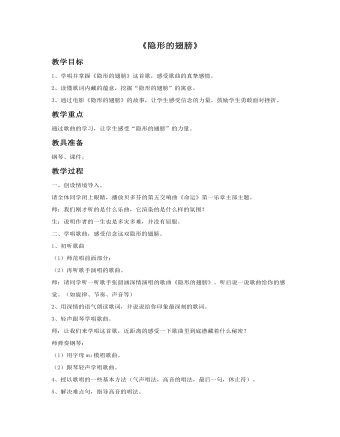
《隐形的翅膀》教案
教学过程一、创设情境导入。请全体同学闭上眼睛,播放贝多芬的第五交响曲《命运》第一乐章主部主题。师:我们刚才听的是什么乐曲,它渲染的是什么样的氛围?生:说明作者的一生也是多灾多难,并没有屈服。二、学唱歌曲,感受信念这双隐形的翅膀。1、初听歌曲(1)师范唱前面部分;(2)再听歌手演唱的歌曲。师:请同学听一听歌手张韶涵深情演唱的歌曲《隐形的翅膀》。听后说一说歌曲给你的感觉。(如旋律、节奏、声音等)2、用深情的语气朗读歌词,并说说给你印象最深刻的歌词。3、轻声跟琴学唱歌曲。师:让我们来学唱这首歌,近距离的感受一下歌曲里到底潜藏着什么秘密?师弹奏钢琴:(1)用字母wu模唱歌曲。(2)跟琴轻声学唱歌曲。4、授以歌唱的一些基本方法(气声唱法,高音的唱法,最后一句,休止符)。5、解决难点句,指导高音的唱法。6、完整而深情的演唱歌曲。7、为歌曲创编舞蹈(融汇手语与舞蹈),动员学生全体参与,并边歌边舞。8、抛出问题:什么事隐形的翅膀,导出下一环节。
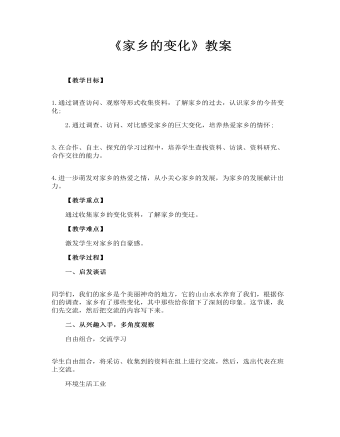
《家乡的变化》教案
一、启发谈话 同学们,我们的家乡是个美丽神奇的地方,它的山山水水养育了我们,根据你们的调查,家乡有了那些变化,其中那些给你留下了深刻的印象。这节课,我们先交流,然后把交流的内容写下来。 二、从兴趣入手,多角度观察 自由组合,交流学习 学生自由组合,将采访、收集到的资料在组上进行交流,然后,选出代表在班上交流。 环境生活工业 多角度观察农业、旅游、饮食、交通
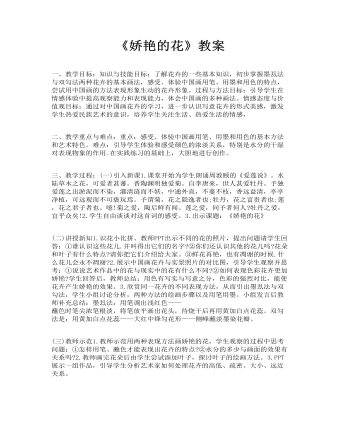
《娇艳的花》教案
二、教学重点与难点:重点:感受、体验中国画用笔、用墨和用色的基本方法和艺术特色。难点:引导学生体验和感受颜色的浓淡关系,特别是水分的干湿对表现物象的作用.在实践练习的基础上,大胆地进行创作。 三、教学过程:(一)引入新课1.课堂开始为学生朗诵周敦颐的《爱莲说》。水陆草木之花,可爱者甚蕃。晋陶渊明独爱菊。自李唐来,世人甚爱牡丹。予独爱莲之出淤泥而不染,濯清涟而不妖,中通外直,不蔓不枝,香远益清,亭亭净植,可远观而不可亵玩焉。予谓菊,花之隐逸者也;牡丹,花之富贵者也;莲,花之君子者也。噫!菊之爱,陶后鲜有闻。莲之爱,同予者何人?牡丹之爱,宜乎众矣!2.学生自由谈谈对这首词的感受。3.出示课题:《娇艳的花》

《飞的更高》教案
教学过程一、创设情境导入。先弹奏一遍《飞得更高》的音乐,吸引同学们的兴趣。师:同学们以前有没有听过汪峰的歌曲?感觉它的风格是什么样的?(《怒放的生命》,摇滚型歌手)生:……师:同学们以前有没有听过这首歌?听完这首歌有什么样的感受?生:励志、向上、振奋……师:想象一下这首歌所呈现的画面。(歌曲像一条大河,缓缓流过,起初平静,时而急流时而狭窄,逐渐开阔。如同生命。听者会被带入一种境界,如同站在网中漫步一片辽阔的旷野,雄鹰在头顶的天空翱翔,令心中有一种欲望在疯长,无法遏止。)
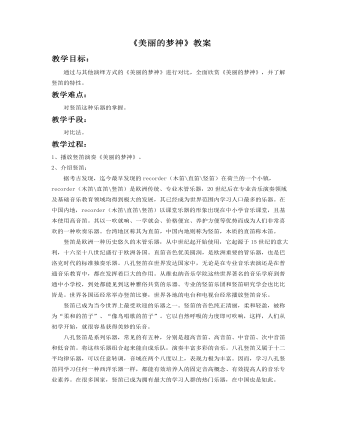
《美丽的梦神》教案
据考古发现,迄今最早发现的recorder(木笛\直笛\竖笛)在荷兰的一个小镇,recorder(木笛\直笛\竖笛)是欧洲传统、专业木管乐器,20世纪后在专业音乐演奏领域及基础音乐教育领域均得到极大的发展,其已经成为世界范围内学习人口最多的乐器。在中国内地,recorder(木笛\直笛\竖笛)以课堂乐器的形象出现在中小学音乐课堂,且基本使用高音笛。其以一吹就响、一学就会、价格便宜、养护方便等优势而成为人们非常喜欢的一种吹奏乐器。台湾地区称其为直笛,中国内地则称为竖笛,木质的直笛称木笛。竖笛是欧洲一种历史悠久的木管乐器,从中世纪起开始使用,它起源于15世纪的意大利,十六至十八世纪盛行于欧洲各国。直笛音色优美圆润,是欧洲重要的管乐器,也是巴洛克时代的标准独奏乐器。八孔竖笛在世界发达国家中,无论是在专业音乐表演还是在普通音乐教育中,都在发挥着巨大的作用。从维也纳音乐学院这些世界著名的音乐学府到普通中小学校,到处都能见到这种雅俗共赏的乐器。专业的竖笛乐团和竖笛研究学会也比比皆是。世界各国还经常举办竖笛比赛,世界各地的电台和电视台经常播放竖笛音乐。

《如歌的行板》教案
教学过程:(一)导入(播放大家熟悉的俄罗斯音乐,创设意境)问题一:同学们,我们刚才欣赏的是什么风格的音乐?(……)问题二:那同学们还有哪些会唱的俄罗斯歌曲呢?(请同学们哼唱)问题三:大家感觉俄罗斯音乐有什么特点呢?(充满诗意、深情、宁静、忧伤……)1、介绍作曲家:(播放视频资料,柴科夫斯基以及他的作品剧照)柴科夫斯基,俄国作曲家,生于贵族家庭。他是一个善良、忧郁的音乐诗人,被奉为世界级音乐旋律大师,也是浪漫乐派代表之一。他动人的音乐深深地打动了全世界人民,提到俄国音乐家,往往第一个就会想到他,可以说他是俄国民族音乐继承者与西方音乐的汲取发扬者。2、他创作的作品中,有大家所熟悉的舞剧《天鹅湖》、《睡美人》、《胡桃夹子》和交响诗《罗密欧与朱丽叶》、《悲怆》等。他的音乐充满内心情感和戏剧力量,不仅深为专业音乐工作者喜爱,而且也为广大群众所赞赏。3、要求同学们重点记住他的三部舞剧:《天鹅湖》、《睡美人》、《胡桃夹子》。
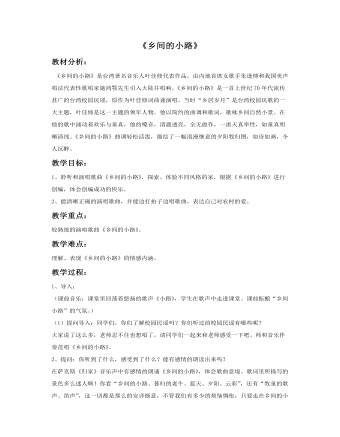
《乡间的小路》教案
教学过程:1、导入:(课前音乐:课堂里回荡着悠扬的歌声《小路》,学生在歌声中走进课堂。课前酝酿“乡间小路”的气氛。)(1)提问导入:同学们,你们了解校园民谣吗?你们听过的校园民谣有哪些呢?大家说了这么多,老师忍不住也想唱了,请同学们一起来和老师感受一下吧。师和音乐伴奏范唱《乡间的小路》。2、提问:你听到了什么,感受到了什么?能有感情的朗读出来吗?在萨克斯《归家》音乐声中有感情的朗诵《乡间的小路》,体会歌曲意境。歌词里所描写的景色多么迷人啊!你看“乡间的小路、暮归的老牛、蓝天、夕阳、云彩”,还有“牧童的歌声、笛声”,这一切都是那么的安详惬意,不管我们有多少的烦恼惆怅,只要走在乡间的小路上,它们都会随风飘散,消失得无影无踪。这么优美如诗、风光如画的歌曲,让我们再聆听一遍,请大家一边视听一边思考:歌曲可以分为几个部分?每个部分给你的情绪感受都是一样的吗?播放歌曲视频。3、新课:(1)欣赏歌曲《乡间的小路》,边听边用脚轻踩拍子,注意重拍。 a、歌曲所表现的内容是什么?情绪如何? b、歌曲的重拍在哪?是几拍子?(第二遍聆听)

人教版高中地理选修2三峡工程对生态环境和名胜古迹的影响及对策教案
一、三峡工程的生态环境效应三峡工程的生态环境效应是指建设三峡工程对生态与环境的有利和不利影响。1、有利影响(1)防洪:(2)防治血吸虫病:(3)减轻洞庭湖淤积(4)增加枯水期流量,改善水(5)调节局部气候:(6)减轻环境污染:综上所述,三峡工程对生态环境的有利影响主要在中下游。2、不利影响及措施(1)淹没土地、耕地:水库蓄水将淹没土地、耕地。(2)加剧水土流失和环境污染:在移民开发和城市迁建过程中,处理不当可能产生新的水土流失和环境污染等问题。(3)诱发地质灾害(地震、滑坡):水库蓄水改变了原有地应力的平衡,可能诱发地震,并使库岸发生滑坡等地质灾害的可能性增大。(4)加重泥沙淤积:水库蓄水,使库区水流速度变慢,库区和库尾的泥沙淤积加重。
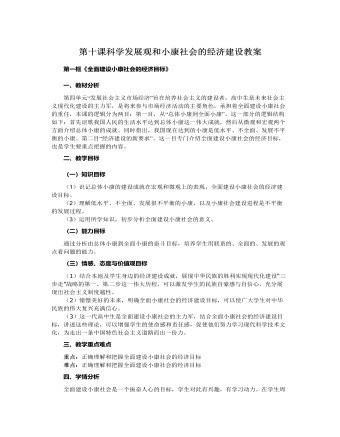
人教版高中政治必修1第十课科学发展观和小康社会的经济建设教案
一、教材分析第四单元“发展社会主义市场经济”旨在培养社会主义的建设者,高中生是未来社会主义现代化建设的主力军,是将来参与市场经济活动的主要角色,承担着全面建设小康社会的重任,本课的逻辑分为两目:第一目,从“总体小康到全面小康”。这一部分的逻辑结构如下:首先讴歌我国人民的生活水平达到总体小康这一伟大成就,然后从微观和宏观两个方面介绍总体小康的成就。同时指出,我国现在达到的小康是低水平、不全面、发展不平衡的小康。第二目“经济建设的新要求”。这一目专门介绍全面建设小康社会的经济目标,也是学生要重点把握的内容。二、教学目标(一)知识目标(1)识记总体小康的建设成就在宏观和微观上的表现,全面建设小康社会的经济建设目标。(2)理解低水平、不全面、发展很不平衡的小康,以及小康社会建设进程是不平衡的发展过程。(3)运用所学知识,初步分析全面建设小康社会的意义。
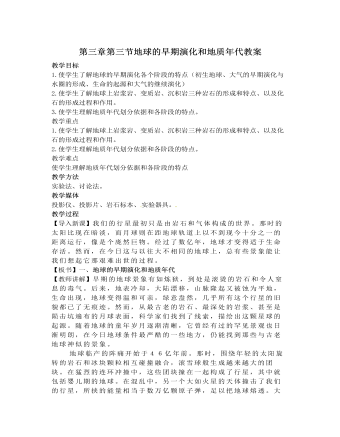
人教版高中地理选修1第三章第一节地球的早期演化和地质年代教案
地质年代可分为相对年代和绝 对年龄(或同位素年龄)两种。相对地质年代是指岩石和地层之间的相对新老关系和它们的时代顺序。地质学家和古生物学家根据地层自然形成的先后顺序,将地层分为5代12纪。即早期的太古代和元古代(元古代 在中国含有1个震旦纪),以后的古生代、中生代和新生代。古生代分为寒武纪、奥陶纪、志留纪、泥盆纪、石炭纪和二叠纪,共7个纪;中生代分为三叠纪、侏罗纪和白垩纪,共3个纪;新生代只有第三纪、第四纪两个纪。在各个不同时期的地层里,大都保存有古代动、植物的标准化石。各类动、植物化石出现的早晚是有一定顺序的,越是低等的,出现得越早,越是高等的,出现得越晚。绝对年龄是根据测出岩石中某种放射性元素及其蜕变产物的含量而计算出岩石的生成后距今的实际年 数。越是老的岩石,地层距今的年数越长。

人教版新目标初中英语七年级下册How was your weekend教案2篇
Teaching Goal:1. General aims:Talk about recent past events2. Particular aims:A. Language Focus.Talk about recent past events and think of the past events.B. Language goalsHow was….?It was …What did …do over the weekend?C. Language structures:(1). How was your weekend? I was great. Pay attention to no form.(2). What did you do over the weekend? I played soccer. We went to the beach.D. Useful words and phrases:Words: was, did, went, beach, over, project, test, wasn’t, false, number, geography, spend, week, most, mixture, their, had, little, cook, read, saw, change, everyone, sit, sat, no, anythingPhrases: did one’s homework, played soccer, cleaned my room, went to the beach, played tennis, went to the movies, on Saturday morning, over the weekend, cook … for, what about, do some reading, have a party, talk show, go shoppingE. Grammar language:Present simple past tenseRegular and irregular verbsF. Learning strategies:Tour and holidaysG. Interdiscipinary:H. Emotion and manner:Teaching time: 5 periodsTeaching procedures:Period One教学步骤、时间 教师活动 学生活动 媒体应用Step 1Free talk 3’ Ask some questions like:Who’s on duty today?What’s the weather like? Answer and talk about something.让同学们回答下列问题1. Do you like weekend? (Let some students answer)It takes them three minutes to talk about the question.2. Why do you like weekend? (let the students answer) Most of the students like the weekend此时教师用汉语问:“在周末期间问你干了什么?这句话用英语这么回答?Let the students guess.At last the teacher give them right answer3. What did you do over the weekend?(板书、学习)

人教版新目标初中英语七年级下册Don’t eat in class教案2篇
Don’t fight. =You can’t fight. (板书,教读)教师把这些句子板书在黑板上,并请学生大声整齐地读祈使句和“can’t”句型,并让学生注意两种句型表达形式的不同和转换,“Don’t …=You can’t…”;并对学生说:These are our school rules. (板书,教读) You can’t break the school rules. Don’t break the school rules.(板书,教读)步骤3 :Practicea. T: Now, each of the students is breaking one of these rules.Please finish 1a.学生看图,完成1a的内容,检查答案并大声朗读校规。b. 听录音,完成1b,选出四位学生都违反了哪条校规;听之前,学生要读会英文名。c. 请两位学生朗读1c部分的句型;要求学生两人一组对话表演,SA扮演外校转来新生,SB告知本校校规。(学生可经过讨论,多说出他们想到的校规,不必只限于书上;教师应给予帮助)2) 第二课时(2a~4)步骤1 :warming up of revisionT: What are the rules at your school?学生使用“can”或祈使句表达各条校规;其中老师可引出“eat in the cafeteria outside”的表达。步骤2 :Practicea.T: Christina is an exchange student. She doesn’t know the rules. Let’s listen, what activities they’re talking about?学生听第一遍时,完成2a;第二遍时,完成2b;b. 请学生领读2c部分,看着2a完成的表格,理解2c活动的要求;分成小组针对2a进行问答;

人教版新目标初中英语七年级下册I want to be an actor教案2篇
三、教学建议第一课时:1. Lead in (Vocabulary)A) Before class, teacher should collect some pictures of working places. For example: Bank, TV Station, Restaurant, Police Station, Hospital ...B) In class, show students the pictures (PowerPoint, OHP). Ask students to tell the name of the working places and the name of the jobs.Shop assistant, doctor, actor, reporter, police office, waiter, bank clerk, studentC) Do exercise 1a and 3a.2. Bingo GameAsk groups of students to make up pairs of cards with a job on one and the related workplace on the other. For example, waiter / restaurant, teacher / school, doctor / hospital. Encourage students to use both the job / workplace combinations in the book and the ones that students came up during class discussions. Be sure they have twice as many sets of cards as there are students in the group. They can make two sets of cards for a single job / workplace, if necessary. Then have each group mix up its set of cards and hand their cards out in random order. Each time a student gets a pair of cards that match, he or she can lay these cards down. The goal is to have no cards in your hand at the end.3. Task OneA) Ask students to work in pairs and ask the partner what does he / she want to be in the future.e. g. :What do you / does he / does she want to be?I want to be a.Why?Because it's (adj).B) Vocabulary: Section B, 1a4. Homework 1.2.

人教版新目标初中英语八年级下册It’s a nice day, isn’t it教案2篇
"Hello! Welcome to English class! Introduce yourself. Meet your new classmates." That's what the teacher says. What do you say? "Oh no!" It can be difficult talking to new people. But it can be fun, and you can make friends. How do you do it? Make small talk. Small talk is polite conversation. "Wang Nan is a great pingpang player, isn't she?" "I'd love to meet her, wouldn't you?" "It's been raining a lot, hasn't it?" Tag questions are a form of polite speech. To make small talk successfully, you should know how to make them. You should also know what topics to talk about. Try to learn this unit carefully. The next time you're in English class, you'll find out. Making small talk's easy, isn't it? (“你好!欢迎你!请做一下自我介绍。认识一下你的新同学。”通常在课上老师会这样说。你会说什么呢?“噢,不!”与陌生人谈话太困难了。但是这也很有意思,并且你还能交到朋友。你该怎么做呢?闲聊。闲聊指得是礼貌的对话。“王楠是一个很棒的乒乓球运动员,不是吗?”“我希望自己能认识她,你呢?“今年的雨水很多,不是吗?”反意疑问句是一种礼貌用语。为了使得谈话成功,你应该知道怎样去进行闲聊。你还应该知道与不同的人该谈论什么样的话题。认真的学习这个单元吧,下次在英语课上,你会发现与大家展开谈话是一件很容易的事情,不信我们来试试。)

人教版新目标初中英语八年级下册He said I was hard-working教案2篇
This activity introduces some new vocabulary and provide oral practice using the target language.Task 1 . Ask four students to stand in front of the class, and the teacher asks them the following questions as a reporter.1.What are you going to do when you grow up?2.What are you going to do next week?3.What are going to do after school?The students will give different answers, then ask a good student to report what they said.I am going to e a doctor.What did she say?----------She said she was going to be a doctor.I am going to have a party on Friday night.What did he say?-------He said he was going to have a party on Friday night.I am going to do my homework.What did she say ?------ She said she was going to do her homework.I am going home after school.What did she say?-----She said she was going home after school.Say In this unit we are going to learn to use words like to report what someone said.Task 2. Read the instructions. Then ask a student to read the four questions. And write the words on the Bb. Explain what soap opera is.Task 3. Ask the students to Look at the pictures, point out the TV screens in the picture. Ask one girl to read what Marcia said.What did Marcia say? She said She said she was having a surprise party for Lana on Friday night. Repeat the other pictures in the same way.Activity3. Listen and number the pictures in activity 1a.

人教版新目标初中英语八年级下册How long have you been collecting shells教案2篇
Step Ⅱ Show the new words on the screen and teach the new words. Read the new words to students and ask them to repeat.Step Ⅲ 3aThis activity introduces new vocabulary and provides reading practice using the target language.In this activity first look at the four pictures.T: What can you see in the pictures?Ss: Four snow globes.T: Right. There are four snow globes in the pictures. And what are they?Ss: They are a monster, two polar bears, two penguins and a birthday cake.Write these words on the blackboard: snow globe; monster; polar bear; penguin and birthday cake. Read them to the class and ask students to repeat each one. Make sure students understand each word.Use a computer to show the E-mail message on the screen and read the message to students.Get students to read the e-mail on their own, and then draw lines connecting each snow globe and its description.Correct the answers.AnswersA line should connect each snow globe picture with the words that describe it in the letter.Step Ⅳ 3bThis activity provides writing practice using the target language.First review Activity 2a on Page 47.Then ask students to complete the message according to Activity 2a.Some partial sentences are given to students. Write about one person's collection.When students work, walk around the room checking the progress and offering help as needed.When they finish, ask some students to read their messages to the class.

人教版新目标初中英语七年级下册Where is the post office教案2篇
Period 2 (3a----Section B 2c)Preview(Pre-task): Key points: What laAdd another information about their pen pals----their language on the cardnguage does she/he speak?She/He speaks....Does she/he have any brothers and sisters? Does she/he speak English?Preview(Pre-task): Add another information about their pen pals----their language on the cardKey points: What language does she/he speak?She/He speaks....Does she/he have any brothers and sisters? Does she/he speak English?Step 1 Revision1.Revisionand dictation of the new words 2.Revise the drills they learned yesterday.(by pairwork and grammar exercise)Step 2 Leading-inT has a conversation with one student. The conversation is following:---Do you have a pen pal?---Yes, I do.---What's your pen pal's name? ---His/Her name is....---Where is your pen pal from? ---He/She is from...---Where does he/she live? ---He/She lives in....---What language does he/she speak?He/She speaks...Write the new words on the Bb. They are following: EnglishChineseJapaneseFrenchStep 3 LearnLearn the new words with the whole class.Finish 3a with the students3b Pairwork T still does an example with one student Then the Ss practise in pairs. The example is following:--Curry Muray is my pen pal. He is from the United States.---What language does he speak?

人教版新目标初中英语七年级下册It’s raining教案2篇
1 Each group choose one place to describe and what you are doing in it Choose one place, and describe what they are doing 2 Move around the room and give suggestions Talk about it and write it down 3 Ask one to show their works and act it Choose one of each group to make a report 4 Evaluate the best group and the best reporter Choose the best one Homework Ask your friends their ideal place and write about it教学反思:新课程标准中强调学生在课堂中的主体地位,在综合课中他们的主体地位就更加突出。在各个活动中给不同程度的学生不同层次的任务,让各层面的学生都有表现发挥的机会,从而产生对英语的兴趣。使用照片图片多媒体来辅助教学,效果更好。同时让了解其他国家风景,风俗的同学介绍ideal place,增加学生的背景知知识,实现跨学科交流的目的。教案点评:采用任务型教学模式,在各个活动中给不同程度的学生不同层次的任务,让各层面的学生都有表现发挥的机会,从而产生对英语的兴趣。使用照片图片多媒体来辅助教学,效果更好。让了解其他国家风景,风俗的同学介绍ideal place,增加学生的背景知识,实现跨学科交流的目的。